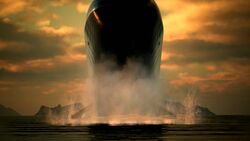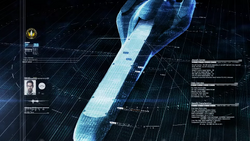- "Heed my words! This boat has the means to end this hideous war, in a definitive and elegant manner."
- ― Captain Matias Torres[1]
The Alicorn is a large nuclear submarine and the only known member of the Alicorn class of submarines. It is the main antagonist in the additional DLC story missions for Ace Combat 7: Skies Unknown.[2]
The Alicorn carries numerous weapons designed for mass destruction, including railguns that can fire shells equipped with nuclear warheads.[2] As the successor to the Scinfaxi class of submarines, the Alicorn also features a runway and landing strip to support squadrons of fighter aircraft.[3]
The Alicorn is captained by Matias Torres, a radical member of the Erusean Navy. Torres wishes to use the Alicorn to kill millions of civilians in cities such as Oured to end the Lighthouse War quickly while at the same time saving ten million more.[2]
Etymology

The Alicorn breaching
"Alicorn" can refer to one of two things:
- the horn of a unicorn, from the Latin translation;[4] the design of the Alicorn—particularly the placement and size of the runway—resembles one of these single-horned creatures. This is especially evident when the Alicorn breaches the water's surface.
- a winged unicorn (a Pegasus with the horn of a unicorn); poet W. B. Yeats depicted winged unicorns as "creatures of ecstatic destruction" in the theatrical play The Unicorn from the Stars.[5] This aligns with the Alicorn carrying armaments equipped with nuclear warheads.[3][2]
Design
Vessel

The design schematics of the Alicorn

The propulsion specifications of the Alicorn
- "The sub's force projection capabilities are equivalent to a carrier strike group."
- ― David North[2]
The Alicorn features a larger and more ambitious design than the Scinfaxi and Hrimfaxi before it. The Alicorn is 495 m (1,624 ft) in length with a long airstrip running down the middle of the submarine,[2] whereas the Scinfaxi was reported to exceed 300 m (980 ft) in length[6] and had a small vertical takeoff platform at the rear of the vessel.[7]
Amidships, the vessel divides into three stern sections: the center airstrip and two large propeller units used for propulsion and its powerful arsenal. Underneath the airstrip, the Alicorn carries two nuclear reactors that power the entire vessel.[2] The Alicorn also features the ability to generate oxygen underwater, allowing crew members to survive when the sub is submerged even in the case of an accident.[3]
The Alicorn's specifications are as follows:[2]
- Length (submerged): 495 m (1,624 ft)
- Beam (submerged): 116 m (381 ft)
- Height (submerged): 54 m (177 ft)
- Displacement
- Submerged: 810,000 tonnes (800,000 long tons; 890,000 short tons)
- Surfaced: 650,000 tonnes (640,000 long tons; 720,000 short tons)
- Propulsion: Two nuclear geared turbines/turbo-electric mixed flow pump jets with conductive internal flow magnetohydrodynamics units
- Power: 300,000 horsepower (220,000 kilowatts) per jet
- Engine: Two liquid metal-cooled nuclear reactors
- Propellers: Seven forward-skewed propellers (estimated)
- Speed
- Submerged: 42 knots (78 km/h; 48 mph)
- Surfaced: 37 knots (69 km/h; 43 mph)
- Crew: 270–350
- Company: 150
- Air wing: 120–200 (20–30 aircraft)
- Force projection capability: 400 kilometres (250 mi)
Weaponry

The Alicorn's two railguns in the deployed position
The Alicorn features powerful weapons on both propeller units.
Multiple Vertical Launch System missile launchers are placed within each propeller unit. These VLS launchers support various short-range[2] and long-range missiles, including SLBMs. The SLBMs can carry various warheads, including 200 kt nuclear warheads.[3] Additionally, the Alicorn carries heavy anti-air armaments along its bow and stern, including CIWS and RAM missile launchers that are deployed from hatches within the hull. [8]
The Alicorn also carries two large electromagnetic railguns, one on each propeller unit, placed in front of the VLS launchers. Each railgun can fire 80 rounds per minute. The sabot in each railgun is 200 mm with a barrel length of 6.5 mm (33 caliber) and the capacity to support 155 mm projectiles, guided by GPS/INS. The projectiles range from Armor-Piercing Composite Rigid (APCR) shells to High-Explosive Anti-Ship (HEAS) shells and even to specialized neutron warhead projectiles. These 1 kiloton-yield projectiles are capable of killing anyone within a 400 metres (1,300 ft) radius around the impact site instantaneously.[2]
In addition to the two side railguns, the Alicorn is also fitted with a hidden, far more powerful railgun used for long-range attacks. The hidden railgun's estimated energy output is at least 500 megajoules. When it fires at minimum-energy trajectory, its effective range is over 3,000 kilometres (1,900 mi). The railgun's projectiles can change their flight paths using terminal guidance provided by an SLUAV. However, should the SLUAV be destroyed, a fail-safe forces the projectiles to immediately self-destruct.[9]
Aircraft

The runway on the Alicorn with two elevators raised
The Alicorn can carry at least 20 and at most 30 aircraft, depending on the type of aircraft and the number of crew required to maintain them. The Alicorn supports five distinct aircraft configurations:[2]
- 20 Su-33 Flanker-Ds
- 22 F/A-18F Super Hornets
- 24 MiG-29Ks
- 30 Rafale Ms (4 operated by SACS)
- An unknown number of SLUAVs
History
Development
Yuktobania initiated "Project Alicorn" in 1998 to create a "Super Scinfaxi-class" submarine that combined the capabilities of the Scinfaxi and Hrimfaxi. The Osean Intelligence Agency's (OIA) Advanced Weapons Analysis division observed sand carriers actively excavating underneath Okchabursk in 1999. The underground facility beneath the city already housed two 400-metre (1,300 ft) docks to repair and maintain the Scinfaxi and Hrimfaxi, but the sand carriers were still excavating an estimated 1,000 cubic metres of sand every day.[2]
The OIA suspected that, within a year, Yuktobania completed construction of a new 600-to-700-metre dock for the "Super Scinfaxi-class" submarine. The OIA observed the steel and weapons being delivered to Okchabursk to estimate the Alicorn's capabilities. The Advanced Weapons Analysis division completed its report on the new submarine on March 27, 2000.[2]
The Alicorn's actual construction period is unknown, nor is it confirmed if Yuktobania ever finished it. By 2012, Yuktobania completed most of the ship's hull. On December 20, 2012, GAZE reported that the Kingdom of Erusea purchased the Alicorn and noted that the submarine was seen two days earlier being towed.[2] Erusea purchased the Alicorn as scrap metal from Yuktobania via a private company known as GR Trading[1], then refurbished it into working condition.[3]
At one point, the Alicorn and its long-range armaments were reported as a potential violation of the START2 treaty.[3]
Launches and grounding
Erusea did not officially launch the Alicorn until January 1, 2015. Matias Torres was eventually assigned as the submarine's captain; on December 2, 2015, he was reassigned as the head of the submarine's pre-commissioning crew.[2]
The Alicorn sailed out for a sea trial on October 9, 2016. It accidentally ran aground underwater one month later on November 10.[2] GAZE reported that the submarine had gone missing in the Spring Sea, 1,300 km (810 mi) south-southeast from the Twinkle Islands. Erusea insisted that "no radioactive materials [were] released in the Spring Sea" and "maritime traffic safety [was not] compromised".[3] The submarine resurfaced two years after sailing, on October 9, 2018.[2] It had gone MIA due to being run aground while underwater and remained on the seafloor for 698 days. Several of the crew perished, though the vast majority survived.[1]
Lighthouse War
Following its discovery and the rescue of the crew, the Alicorn was transferred to the Erusean Navy's reserve fleet on November 3, 2018;[3] the same day, Torres was again reassigned as the head of the pre-commissioning crew.[2] Despite the outbreak of the Lighthouse War the following May, the Alicorn remained dormant in an unknown location since it was not part of Erusea's battle doctrine.[3] At most 30 of the Alicorn's crew members left the ship, but they continued to operate for the Alicorn by sabotaging both Osean and Erusean military forces. One of them, Edgar Saxon, provided Osea's Brigadier General Howard Clemens with false intelligence. Other agents stole railgun-compatible neutron bomb shells for the Alicorn.[9]
Erusea lost the Njord Fleet on August 10, 2019 during Osea's Operation Siren's Song.[10] The next day, Erusea formally commissioned the Alicorn into active duty to plug the deficit in its navy.[2]
On September 4, the Alicorn was docked in Artiglio Port, which was under Osean control at the time.[11] OIA analyst David North contacted the Long Range Strategic Strike Group (LRSSG) to explain the situation. Operating under Brigadier General Clemens' false intelligence, Osea launched Operation Sighthound and sent the LRSSG's Strider Squadron, other OADF aircraft, and a small detachment of OMDF ships to capture the Alicorn. The Erusean Air Force sent wave after wave of fighters, strike aircraft, and even EW aircraft to defend the sub, but the Oseans broke through their defenses. As the battle reached its climax, Erusea's high ranking officials ordered Captain Torres to scuttle the Alicorn immediately, but Torres refused the order, declaring that the Alicorn to no longer be under the jurisdiction of the Erusean military. Leaving its dock, the Alicorn opened fire on the OMDF fleet with its railguns, sinking the landing ship Puffin and several other ships that had taken defensive positions with a single shot, and destroying the rest of the fleet with its missiles. SACS took off from the sub with a cruise missile in tow, attempting to flee the airspace as a decoy to allow the Alicorn to submerge. Trigger shot down all SACS aircraft, but by then, the Alicorn had already submerged and left the area.[1]
On September 10, the Alicorn attempted to shoot down Strider Squadron over Anchorhead Bay with its long-range railgun attacks during Strider's Operation Domino. The first attack managed to damage Húxiān's aircraft, forcing her to retreat. The attacks continued even when Trigger was engaging Mimic Squadron, but did not severely harm Trigger or any other units. After Strider Squadron left the airspace, the Alicorn entered the bay without having to face any resistance thanks to Strider eliminating most Erusean forces. The submarine met with its agents in Anchorhead to resupply and load the neutron bomb shells before leaving, all in less than 10 minutes. The OIA confirmed Edgar Saxon as Brigadier General Clemens' source of intelligence and arrested Clemens.[9]
Gallery
The Alicorn alongside the Erusean Royal Navy
SACS aircraft taking off
The Alicorn during Operation Sighthound
SACS Squadron on the Alicorn's runway
The Alicorn and Trigger depicted as chess pieces
Trivia
- Erusea purchased the Alicorn through a shell company called "GR Trading". Though unconfirmed, "GR Trading" may refer to General Resource Limited, one of the corporations featured in Ace Combat 3: Electrosphere.
References
- ↑ 1.0 1.1 1.2 1.3 SP Mission 01: "Unexpected Visitor", Ace Combat 7: Skies Unknown.
- ↑ 2.00 2.01 2.02 2.03 2.04 2.05 2.06 2.07 2.08 2.09 2.10 2.11 2.12 2.13 2.14 2.15 2.16 2.17 2.18 File:Ace Combat 7 Skies Unknown - Season Pass Mission Trailer.
- ↑ 3.0 3.1 3.2 3.3 3.4 3.5 3.6 3.7 3.8 File:Ace Combat 7 Skies Unknown - DLC Mission Teaser.
- ↑ Shepard, Odell (1930). The Lore of the Unicorn. London: Unwin and Allen. ISBN 9781437508536.
- ↑ https://www.jstor.org/stable/2872885
- ↑ New Submarine.
- ↑ Mission 07: "Front Line", Ace Combat 5: The Unsung War.
- ↑ File:Ten Million Relief Plan Store Image.png
- ↑ 9.0 9.1 9.2 SP Mission 02: "Anchorhead Raid", Ace Combat 7: Skies Unknown.
- ↑ Mission 11: "Fleet Destruction", Ace Combat 7: Skies Unknown.
- ↑ Mission 13: "Bunker Buster", Ace Combat 7: Skies Unknown.










